ROS2服务
版权信息
Copyright 2023 Herman Ye@Auromix. All rights reserved.This course and all of its associated content, including but not limited to text,
images, videos, and any other materials, are protected by copyright law.
The author holds all rights to this course and its contents.Any unauthorized use, reproduction, distribution, or modification of this course
or its contents is strictly prohibited and may result in legal action.
This includes, but is not limited to:
Copying or distributing course materials without express written permission.
Reposting, sharing, or distributing course content on any platform without proper attribution and permission.
Creating derivative works based on this course without permission.
Permissions and InquiriesIf you wish to use or reproduce any part of this course for purposes other than personal learning,
please contact the author to request permission.The course content is provided for educational purposes, and the author makes no warranties or representations
regarding the accuracy, completeness, or suitability of the course content for any specific purpose.
The author shall not be held liable for any damages, losses,
or other consequences resulting from the use or misuse of this course.Please be aware that this course may contain materials or images obtained from third-party sources.
The author and course creator diligently endeavor to ensure that these materials
are used in full compliance with copyright and fair use regulations.
If you have concerns about any specific content in this regard,
please contact the author for clarification or resolution.By enrolling in this course, you agree to abide by the terms and conditions outlined in this copyright notice.
学习目标
- 熟悉ROS2的服务概念
- 了解ROS2服务相关的命令行工具操作
- 熟悉服务通信中的客户端和服务器代码编写
- 熟悉服务通信的测试手段
难度级别
| 初级 | 中级 | 高级 |
|---|---|---|
| √ |
预计耗时
35 mins
学习前提
| 对象 | 类型 | 状态 |
|---|---|---|
| ROS2 Humble | 软件 | 已安装 |
| Ubuntu22.04操作系统 | 软件 | 已确认 |
| Shell的基本使用 | 知识 | 已了解 |
| ROS2 节点 | 知识 | 已了解 |
| ROS2 话题 | 知识 | 已了解 |
什么是服务
服务(Service)是ROS(Robot Operating System)图中节点之间进行通信的另一种方式。它建立在调用和响应模型之上,与主题(Topic)的发布者-订阅者模型不同。虽然主题允许节点订阅数据流并获取持续的更新,但服务仅在客户端专门调用时才提供数据。

服务是一种通信方式,采用的是请求和响应模型,与主题的单向发布-订阅模型形成鲜明对比。话题用于节点之间的单向通信,而服务则支持双向通信,允许客户端向服务端发出请求,服务端处理请求并生成响应。
服务的特性
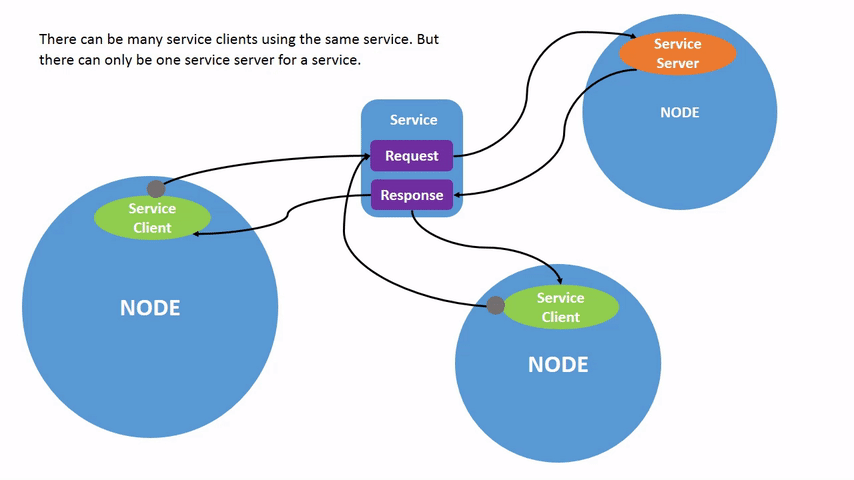
-
服务是一对一或者一对多的
服务可以是一对一或一对多的。这意味着可以有一个客户端向一个服务器请求服务,也可以有多个客户端向同一个服务器请求服务。举个例子,考虑一个早餐店,多个顾客可以来店里请求"购买早餐"的服务。每个顾客传递自己的请求,而服务器则生成相应的响应。 -
服务不适合连续调用情境
服务适合需要请求和响应的场景,其中客户端向节点发出请求以获得特定服务,而服务会处理请求并生成相应的响应。
对于需要持续发布内容而不需要反馈的情况,通常采用话题方式,而服务更适合需要请求和响应的通信需求。这种区分有助于在机器人系统中选择适当的通信方式,以满足不同的应用需求。 -
双向通信
话题是用于单向通信,信息发布者将数据发送到话题,然后订阅者获取这些数据。
这种方式适用于需要将信息广播给多个订阅者的场景,但通常不支持双向通信。
然而,服务提供了一种双向通信的机制,其中客户端(Client)可以向服务端(Server)发送请求,然后服务端会处理请求并发送响应回客户端。
这种请求-响应模型使得服务适用于需要交互式通信的场景,例如请求特定任务的执行并接收结果。
服务的命令行使用
| 命令 | 作用 |
|---|---|
| call | 调用一个服务 |
| find | 查看给定服务类型的可用服务列表 |
| list | 查看可用服务的列表 |
| type | 查看服务的类型 |
让我们以调用 turtlesim 示例中的 /clear 服务为例来讲解服务的命令行使用:
首先,让小乌龟先绘制出一些轨迹,随后使用/clear来清理轨迹
ros2 service call /clear std_srvs/srv/Empty
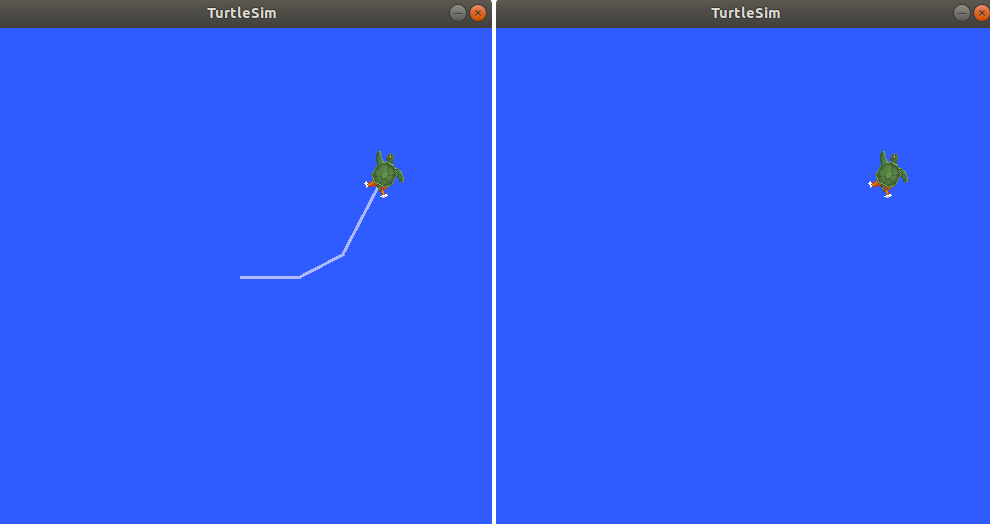
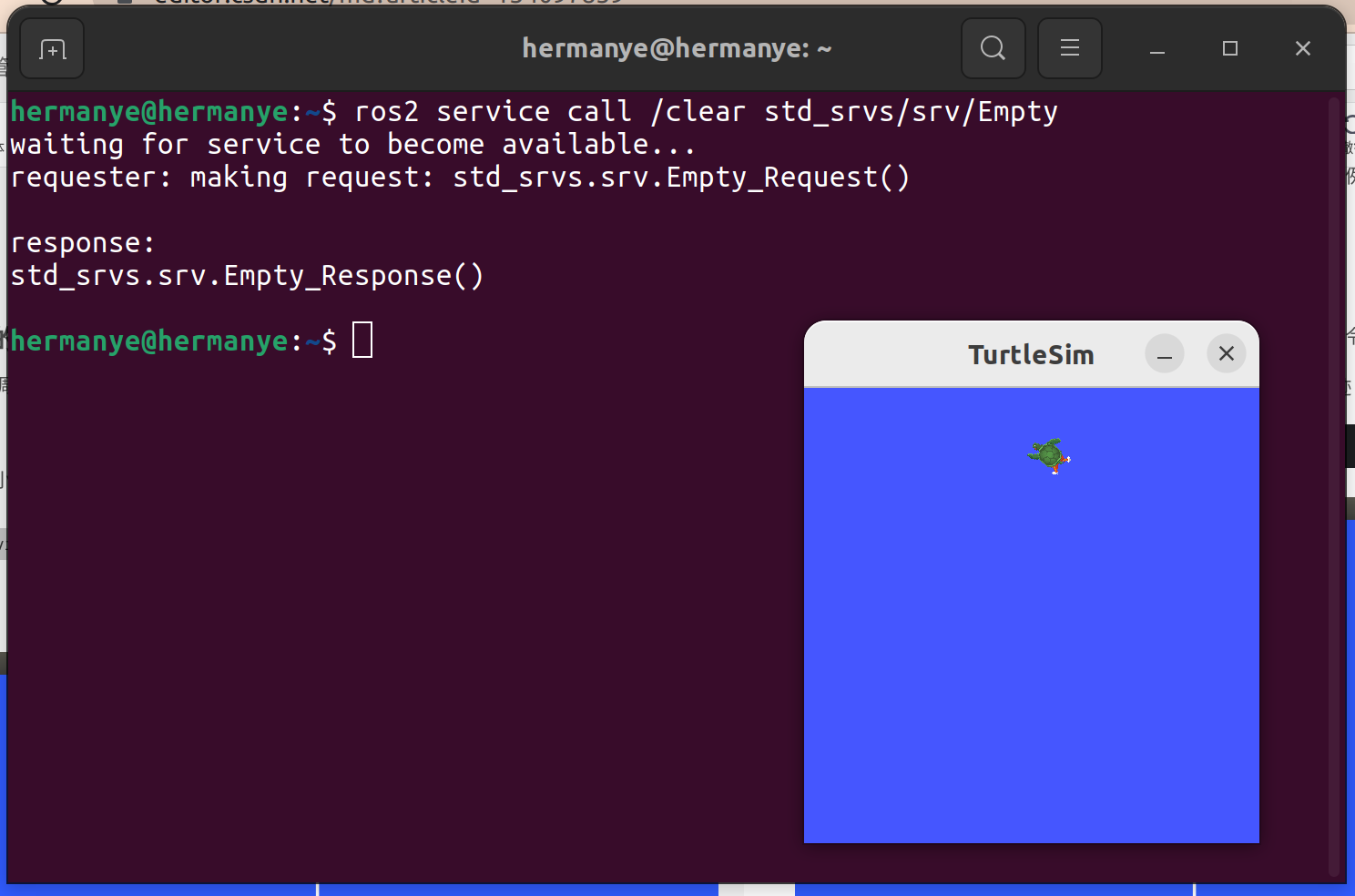
查看可用服务的列表
使用此命令可以输出当前存在的服务列表:
ros2 service list
在ROS2中,每个节点基本上都包含以下六个服务,这些服务用于节点参数的基本设置,关于节点参数的概念将在后续的教程中解释,此处不涉及。
hello_world_demo是一个不包含自定义服务的demo,但仍然可以发现它有一些基本的服务可以调用。
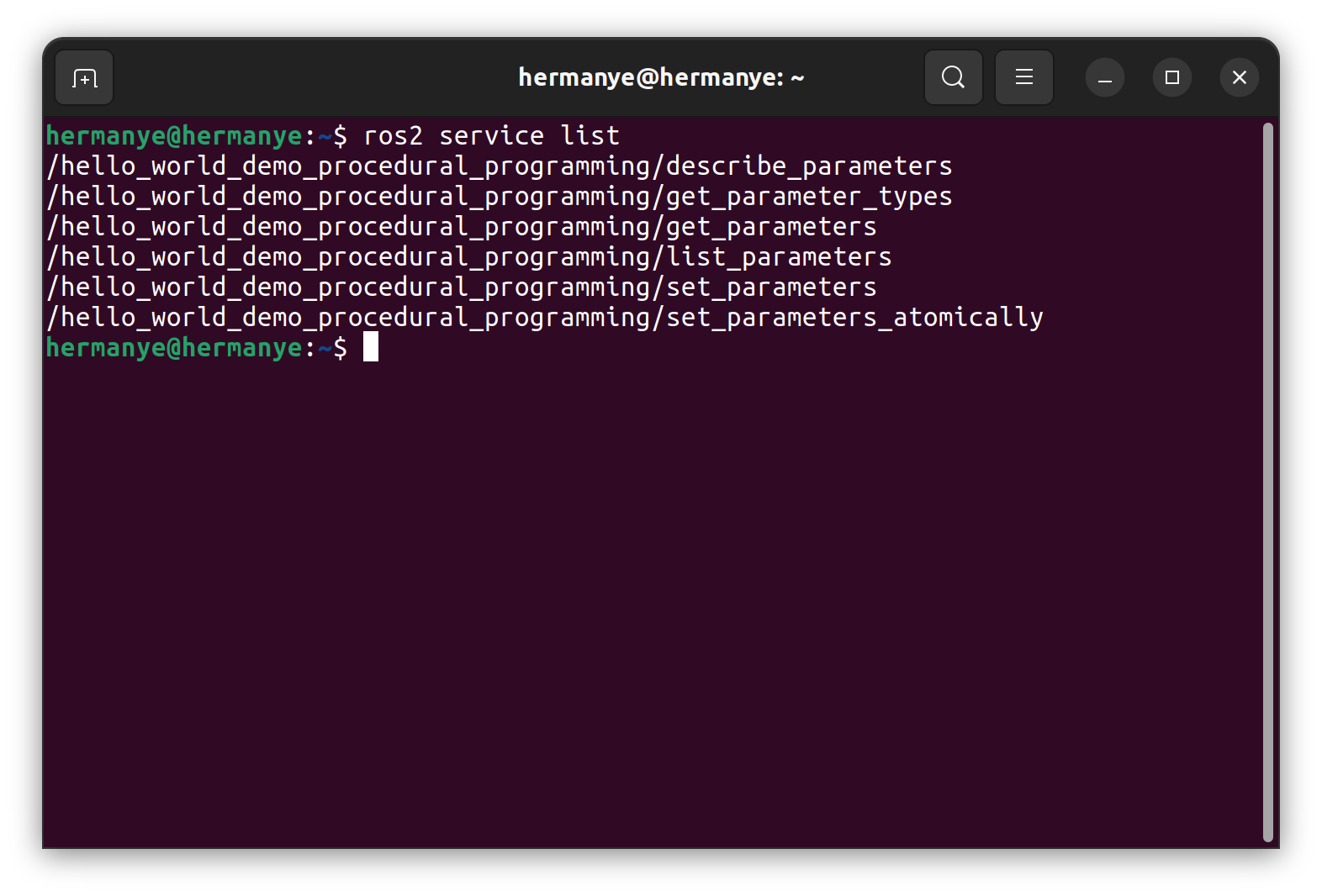
对于turtlesim这样的包,则是有相关的服务可以调用:
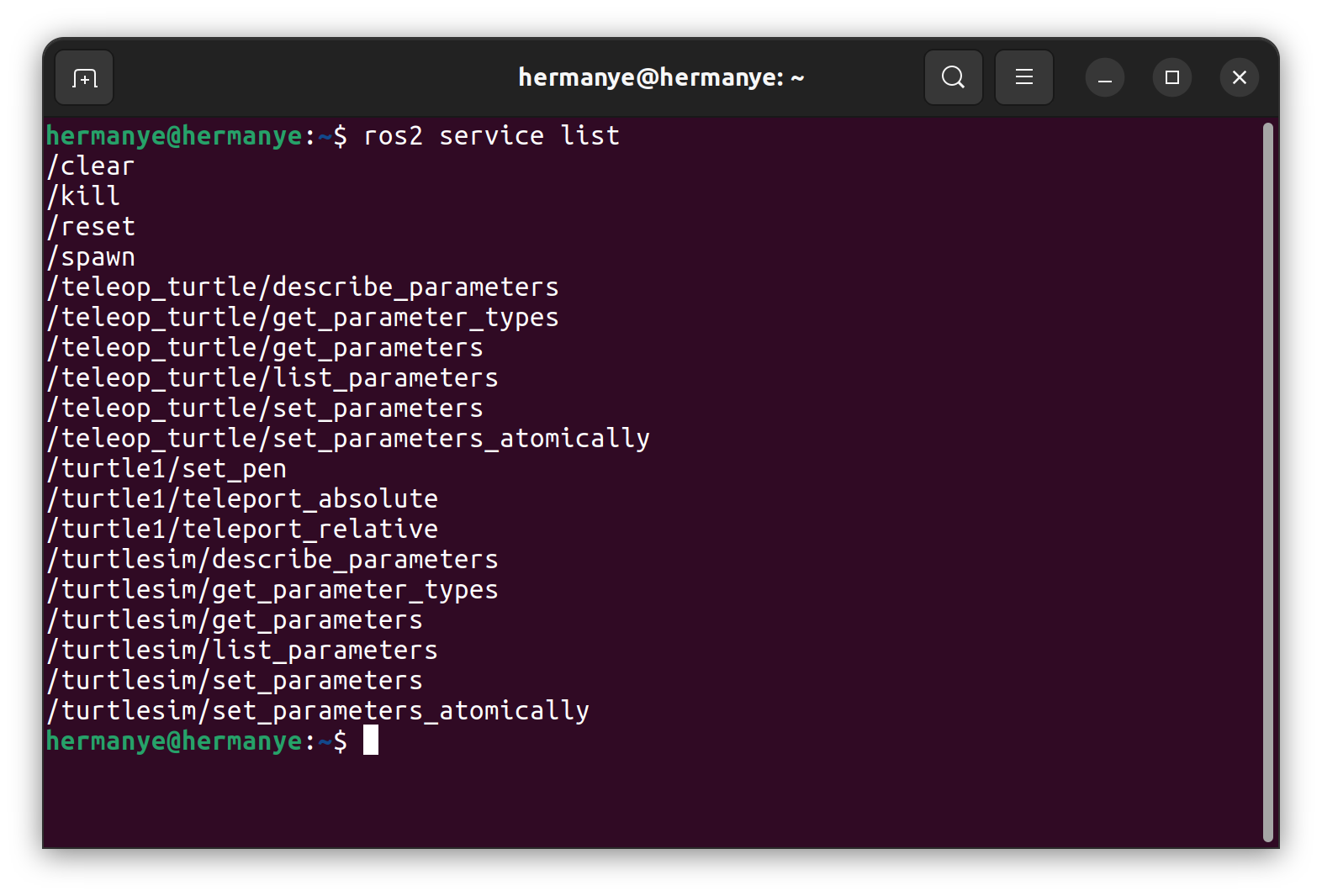
查看服务的消息类型
同样,当添加-t后缀时,会同时输出服务列表和各个服务的消息类型:
ros2 service list -t
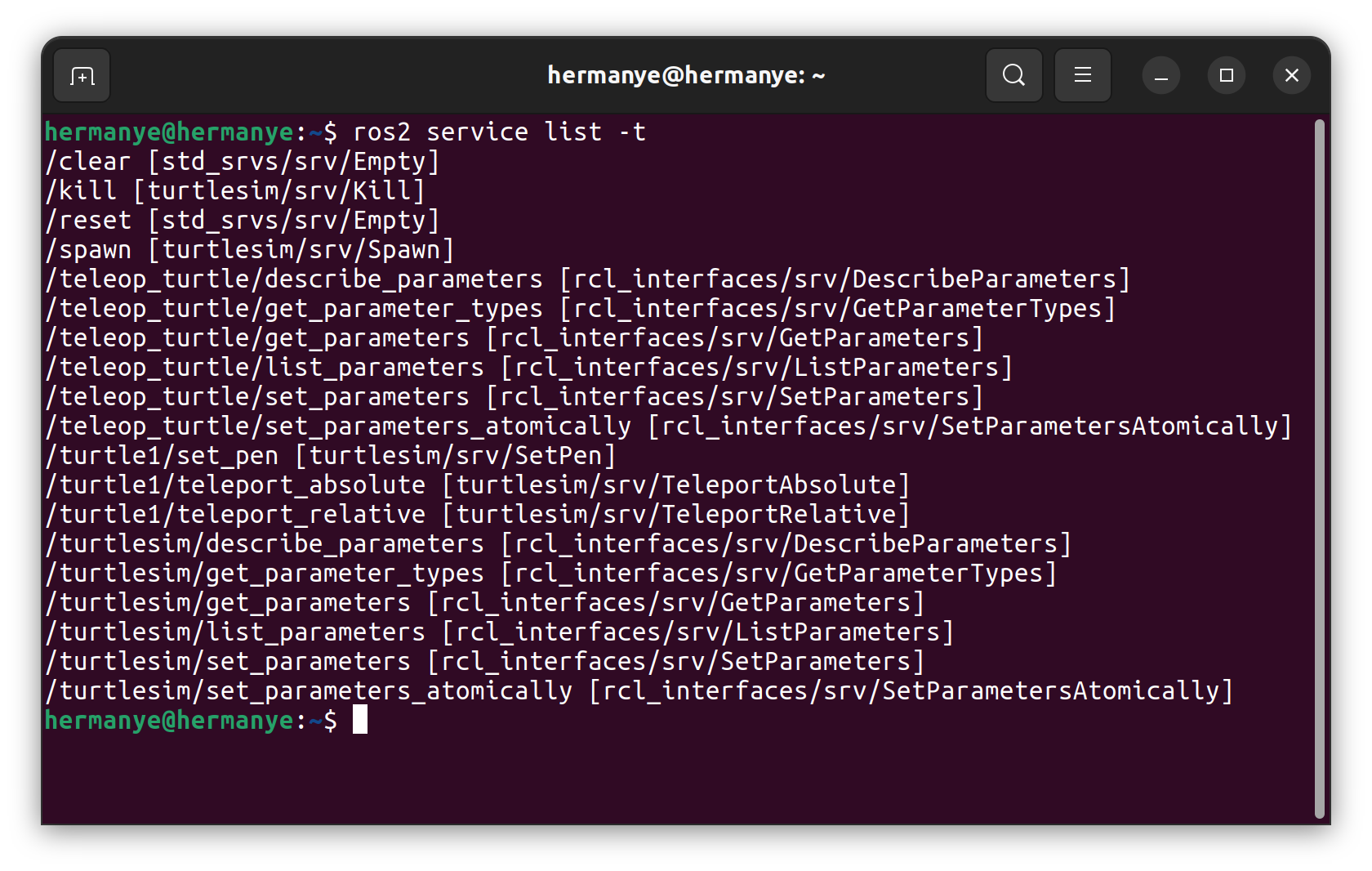
若需要查看特定服务类型的具体结构,可以通过使用 ros2 service type 和 ros2 interface show 命令来完成。首先,使用 ros2 service type 获取服务的类型信息,接着使用 ros2 interface show 获取该类型的具体消息结构。
服务消息类型的结构通常包括两部分:一个用于请求服务的消息结构,另一个用于描述响应服务结果的消息结构。它们之间通过一行三个短横线进行分隔。
以下是示例命令,用于查看名为 `/spawn 的服务类型的具体结构
ros2 service type /spawn
ros2 interface show turtlesim/srv/Spawn
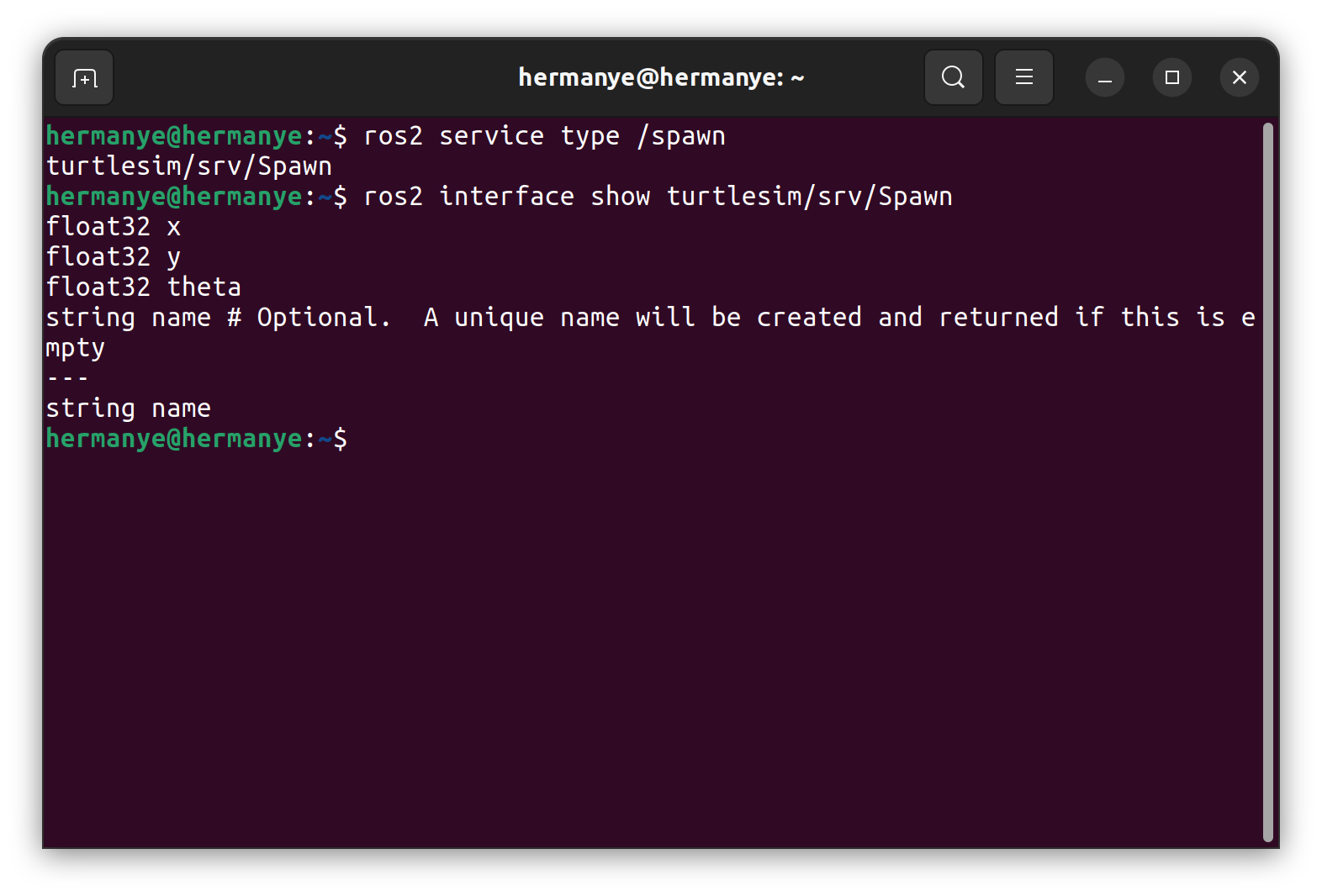
根据服务消息类型反查该类型的服务
根据服务消息类型来检索相应的服务是ROS 2 中的一项常见任务,这个命令会返回与指定消息类型相关联的可用服务的列表。
此处以查找与std_srvs/srv/Empty消息类型相关联的服务为例,我们可以执行以下命令:
ros2 service find std_srvs/srv/Empty
可以看到/clear和/reset都是消息类型为std_srvs/srv/Empty的服务
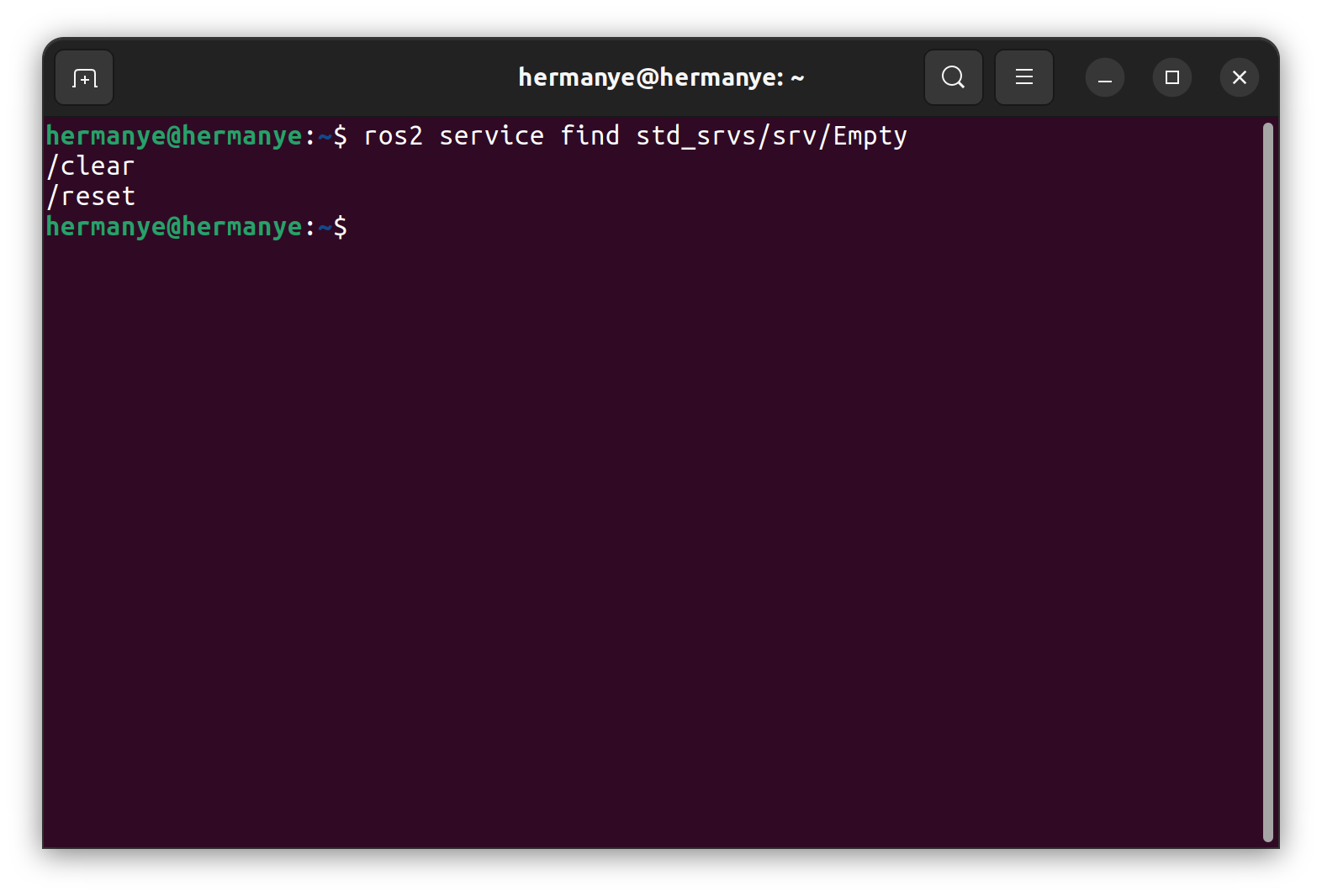
请求服务
在ROS 2中,要通过命令行直接请求服务,你可以使用以下指令:
ros2 service call <service_name> <service_type> <arguments>
让我们以召唤一个海龟(也就是刚才的/spawn服务)为例来说明这个过程:
ros2 service call /spawn turtlesim/srv/Spawn "{x: 2, y: 2, theta: 0.2, name: 'new_turtle'}"
这个命令中指定了需要调用的服务、服务的消息类型、具体的参数(比如乌龟名为’new_turtle’,位置为(2,2),角度为0.2)
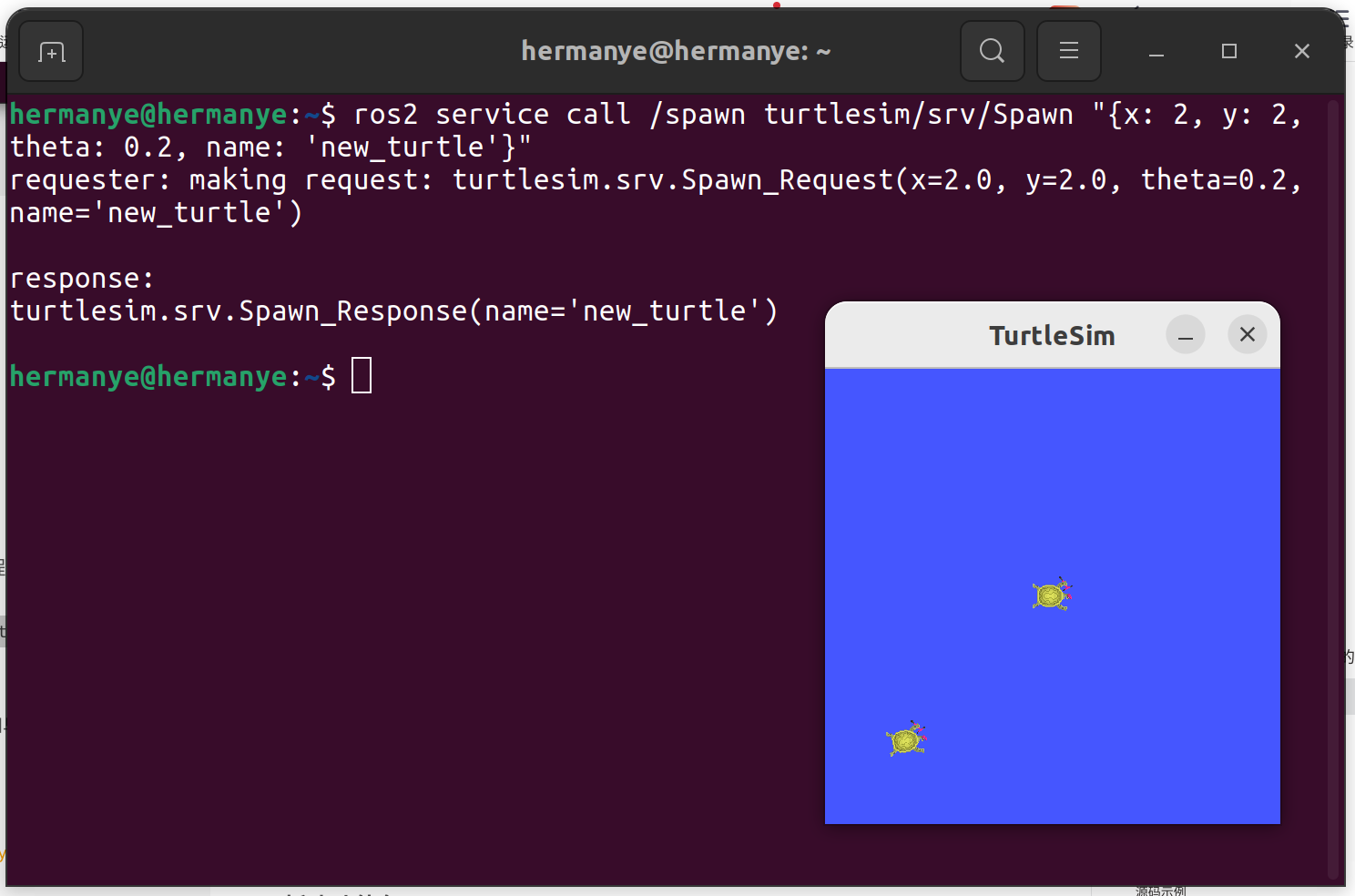
此时再次查看ROS中的节点和话题:
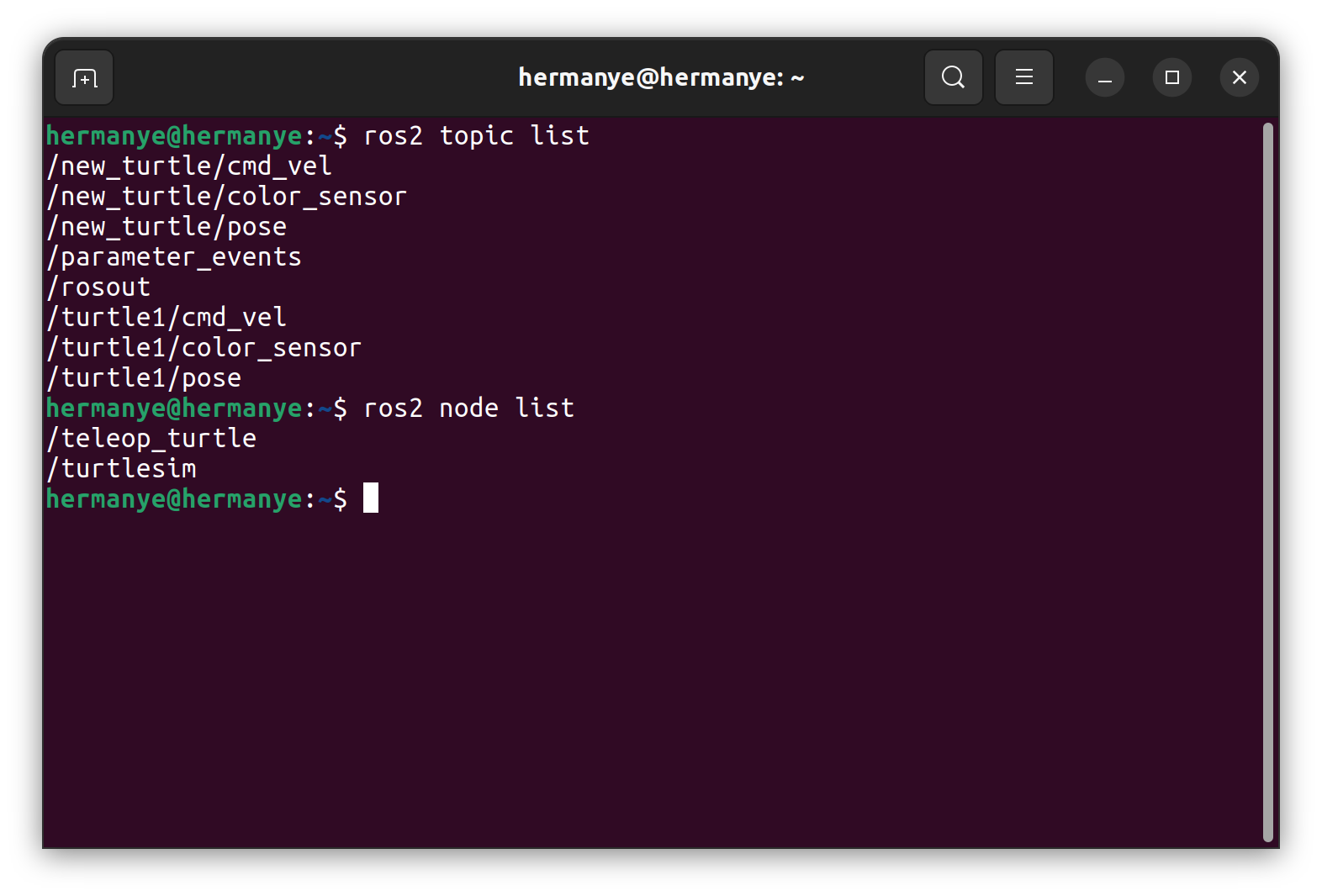
思考:
为什么没有新的节点诞生?
此时如果用键盘节点控制乌龟,会发生什么?为什么?
如何控制新诞生的那只乌龟?
ros2 run turtlesim turtle_teleop_key --ros-args --remap /turtle1/cmd_vel:=/new_turtle/cmd_vel --remap __node:=new_turtle_teleop
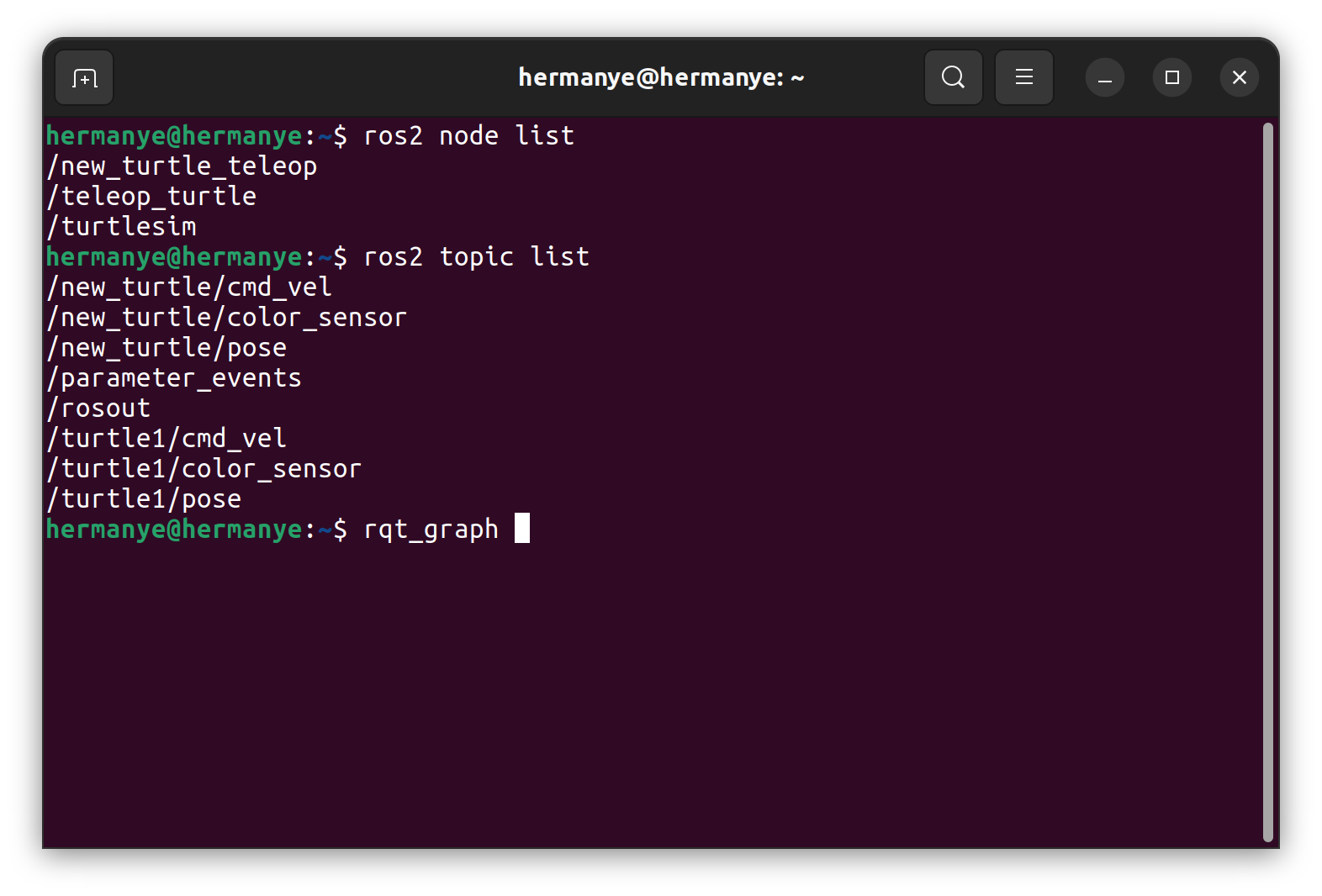

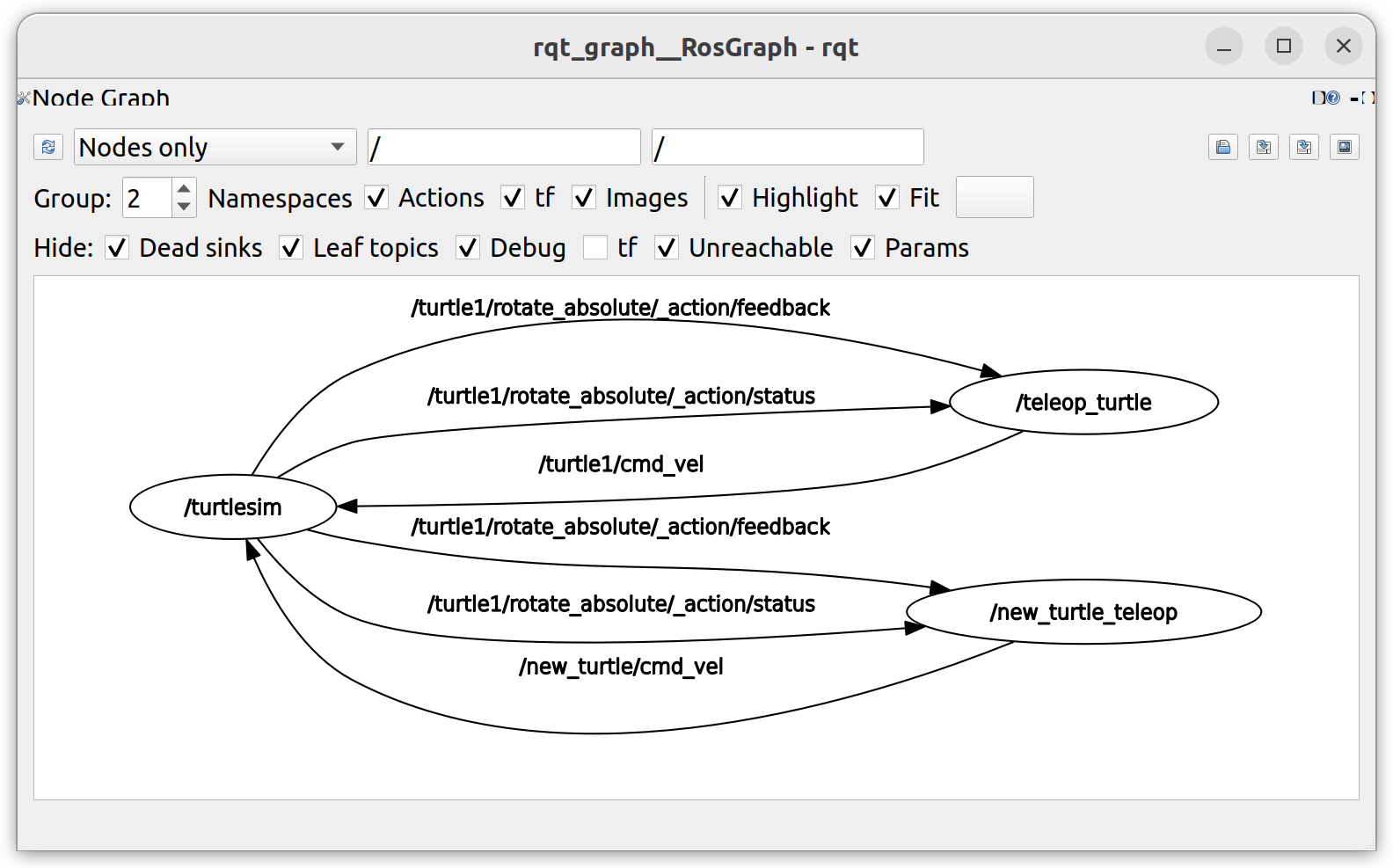
服务的编程使用
服务器
- 编写流程
1.编程接口初始化
2.创建节点并初始化
3.创建服务器端对象
4.通过回调函数处进行服务
5.向客户端反馈应答结果
6.销毁节点并关闭接口
1.创建源码文件
# Go to your src
cd ~/ros2_workspace/src
# Go to your package
cd ros2_learning/ros2_learning
# Create file
touch service_demo_server.py
2.编写源码文件
from example_interfaces.srv import AddTwoInts # 导入需要使用的srv数据类型,AddTwoInts是示例消息接口的类型
import rclpy
from rclpy.node import Nodeclass ServiceDemoServer(Node):def __init__(self):super().__init__("service_demo_server")# 创建server# 数据类型,服务名称,回调函数self.srv = self.create_service(AddTwoInts, "add_two_ints", self.add_two_ints_callback)self.get_logger().info("service_demo_server start")# 回调函数# 通过ros2 interface show example_interfaces/srv/AddTwoInts 查看这个消息类型的结构def add_two_ints_callback(self, request, response):response.sum = request.a + request.bself.get_logger().info("Incoming request\na: %d b: %d" % (request.a, request.b))return response # 回调函数的返回值将被返回def main(args=None):rclpy.init(args=args) # 初始化rclpyservice_demo_server = ServiceDemoServer() # 实例化rclpy.spin(service_demo_server) # 循环rclpy.shutdown() # 关闭if __name__ == "__main__":main()
3.添加依赖
在创建功能包时,添加依赖项是一个关键步骤,因为这些依赖项是功能包所需的其他软件包或库。要实现这一目标,你需要编辑功能包的 package.xml 文件。下面是如何在其中添加依赖的详细步骤:
首先,打开功能包目录下的 package.xml 文件。这个文件包含了关于功能包的元信息和依赖项信息。添加包括功能包的描述、维护者信息和许可证信息。虽然这些信息是可选的,但它们对于更好地了解功能包非常有帮助。
<description>Examples of minimal publisher/subscriber using rclpy</description>
<maintainer email="hermanye233@icloud.com">Herman Ye</maintainer>
<license>Apache License 2.0</license>
随后在 package.xml 中,你需要声明功能包的依赖项。在这个示例中,我们需要依赖两个库:rclpy 和 example_interfaces。
rclpy 是 ROS 2 的 Python客户端库,用于编写 ROS 2 节点。而 example_interfaces 包含了 ROS 2 的官方教程数据类型接口,其中包括了一些用于教学和示例的数据类型,比如 example_interfaces/srv/AddTwoInts,这是本示例中要使用的数据类型。
<depend>rclpy</depend><depend>example_interfaces</depend>
4.添加入口点
接下来,你需要编辑 setup.py 文件,以定义功能包的入口点(entry point)。入口点是功能包中的可执行程序,它们可以在 ROS 2 中运行。在 setup.py 文件中,你需要添加入口点的定义。
首先,更新功能包的元信息,例如:
maintainer='Herman Ye',
maintainer_email='hermanye233@icloud.com',
description='Examples of minimal publisher/subscriber using rclpy',
license='Apache License 2.0',
然后,在 entry_points 部分添加以下命令:
"server = ros2_learning.service_demo_server:main",
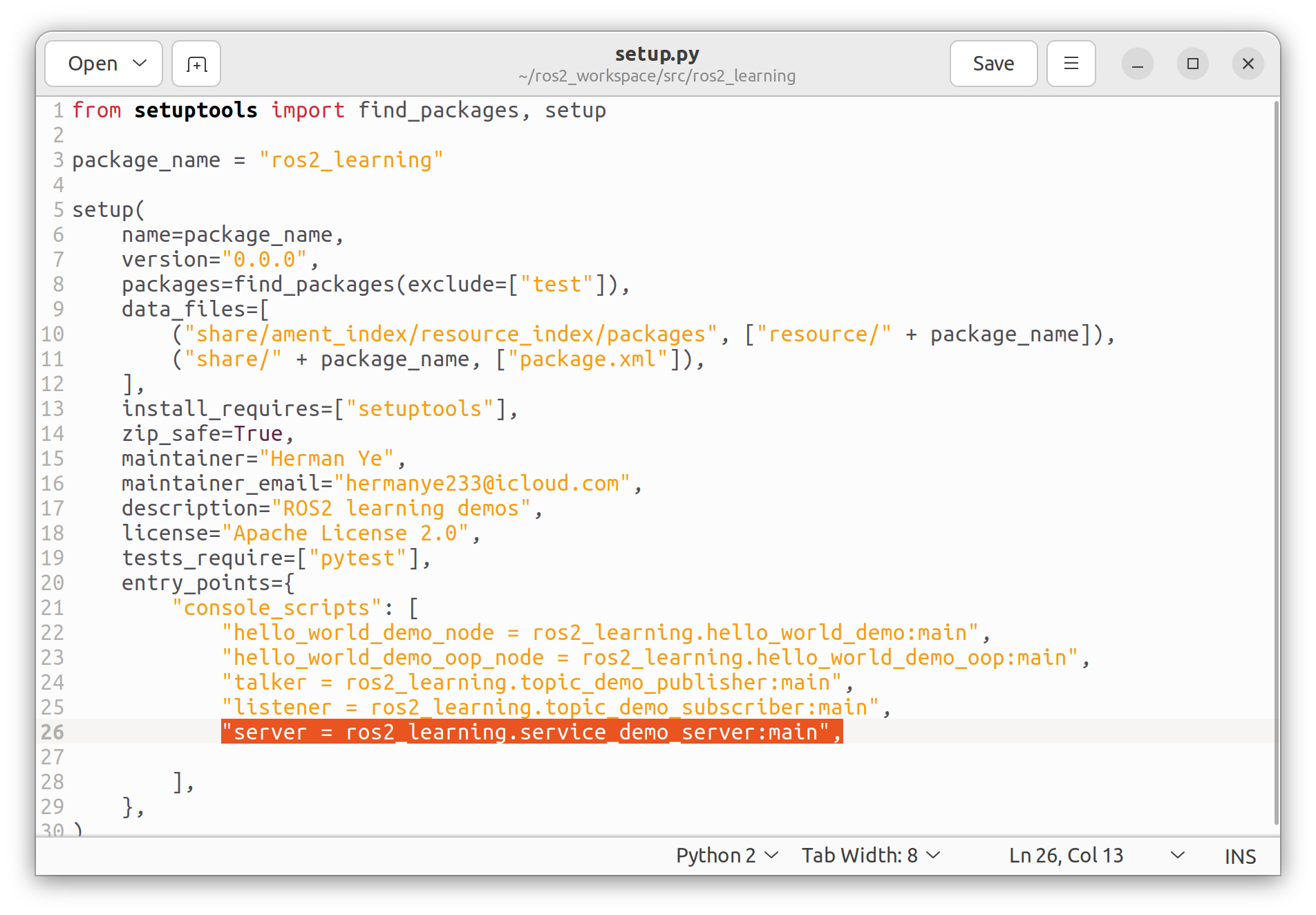
客户端
- 编写流程
1.编程接口初始化
2.创建节点并初始化
3.创建客户端对象
4.创建并发送请求数据
5.等待服务器端应答数据
6.销毁节点并关闭接口
1.创建源码文件
在和服务端相同的目录下新建源码文件:
# Go to your src
cd ~/ros2_workspace/src
# Go to your package
cd ros2_learning/ros2_learning
# Create file
touch service_demo_client.py
2.编写源码文件
import sys # 客户端节点代码使用sys.argv来访问命令行输入的请求命令的参数
from example_interfaces.srv import AddTwoInts # 要使用的数据类型导入
import rclpy # 引入ROS接口
from rclpy.node import Node # 引入节点类class ServiceDemoClient(Node):def __init__(self):super().__init__("service_demo_client") # 以异步通信模式为例# 创建客户端# 数据类型 服务名称self.cli = self.create_client(AddTwoInts, "add_two_ints")# 等待服务出现while not self.cli.wait_for_service(timeout_sec=1.0):self.get_logger().info("service not available, waiting again...")self.req = AddTwoInts.Request() # request部分定义def send_request(self, a, b): # 发送函数self.req.a = aself.req.b = bself.future = self.cli.call_async(self.req) # 异步调用服务rclpy.spin_until_future_complete(self, self.future) # 循环等待直到返回return self.future.result() # 返回结果def main(args=None):rclpy.init(args=args) # 初始化rclpyif len(sys.argv) != 3: # 确保参数个数正确print("Usage: python script_name.py <int_a> <int_b>")returnnum_a = int(sys.argv[1])num_b = int(sys.argv[2])service_demo_client = ServiceDemoClient() # 客户端实例化response = service_demo_client.send_request(num_a, num_b) # 客户端发送请求# 通过ros2 interface show example_interfaces/srv/AddTwoInts 查看这个消息类型的结构service_demo_client.get_logger().info("Result of add_two_ints: for %d + %d = %d" % (num_a, num_b, response.sum))service_demo_client.destroy_node() # 销毁节点rclpy.shutdown() # 关闭ROSif __name__ == "__main__":main()
此处只简单介绍了service的一种发送请求的办法,要获取更多信息请查阅rclpy文档的serviceAPI
3.添加入口点
接下来,你需要编辑 setup.py 文件,以定义功能包的入口点(entry point)。入口点是功能包中的可执行程序,它们可以在 ROS 2 中运行。在 setup.py 文件中,你需要添加入口点的定义。
在 entry_points 部分添加以下命令:
"client = ros2_learning.service_demo_client:main",
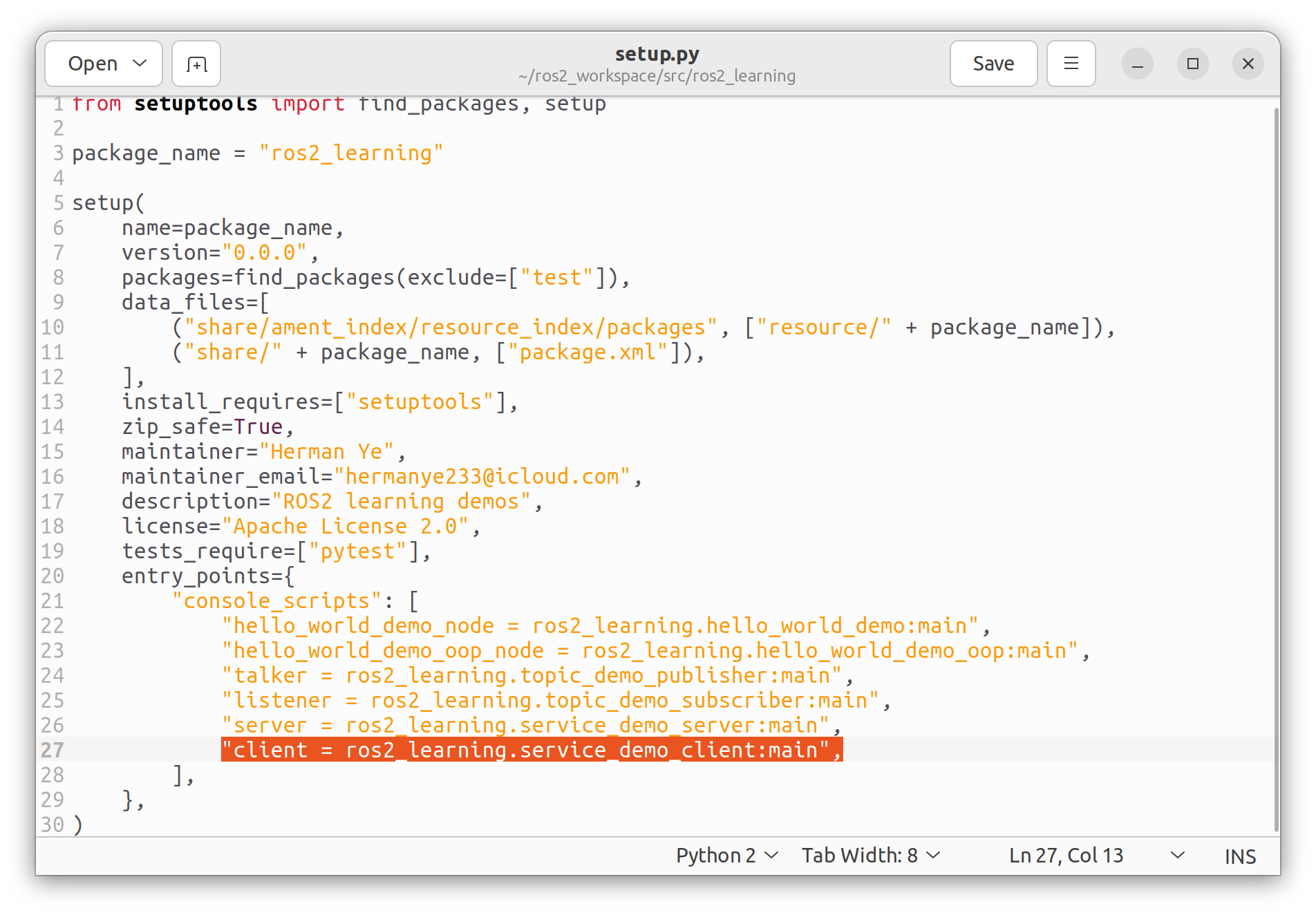
4.编译工作空间
在最后,编译工作空间,相关命令在之后的课程里会讲解,此处不涉及。
# Go to your workspace
cd ~/ros2_workspace
# Build workspace
colcon build --symlink-install
测试服务通信机制
先运行服务器节点:
ros2 run ros2_learning server
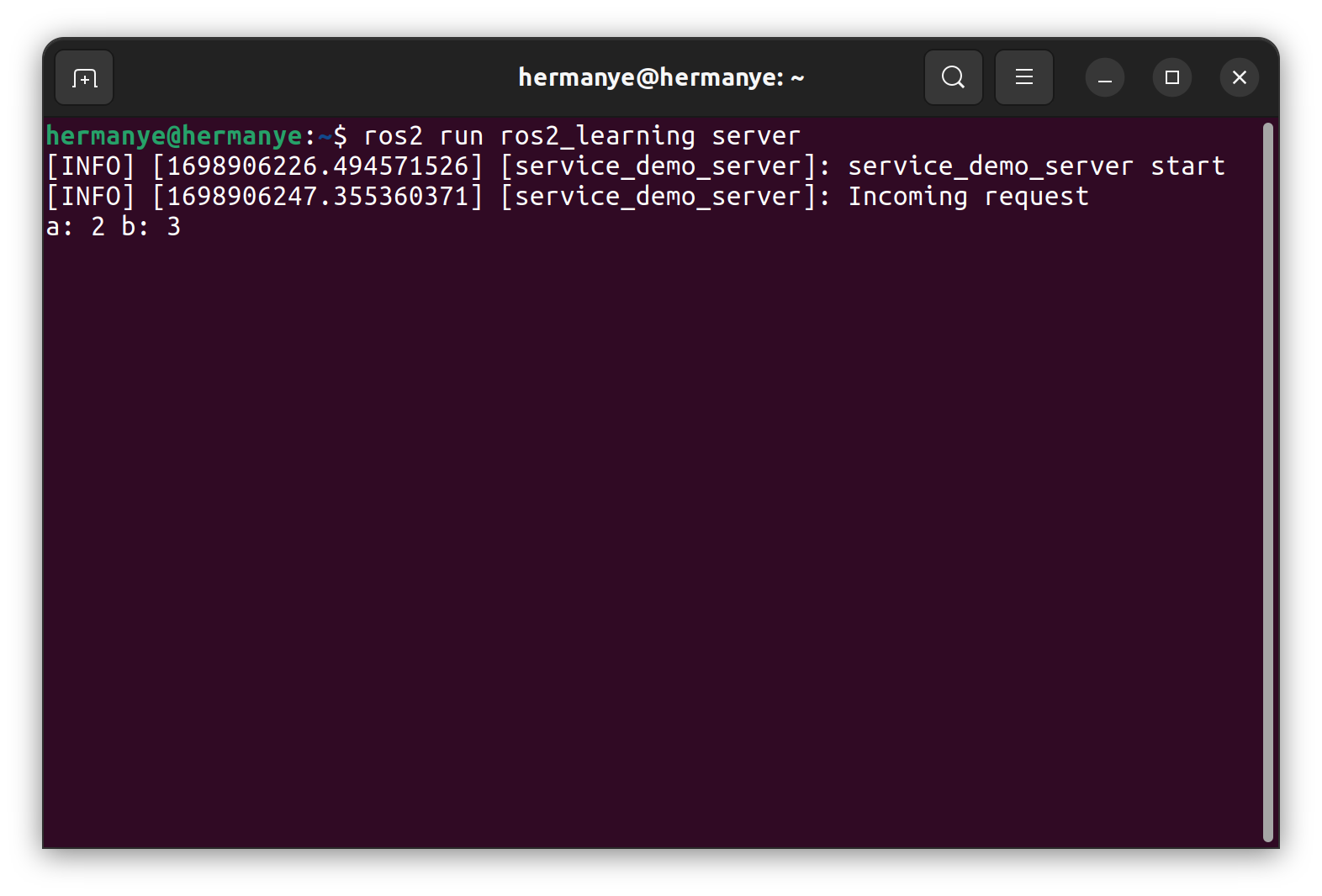
随后运行客户端节点并键入测试参数:
ros2 run ros2_learning client 2 3
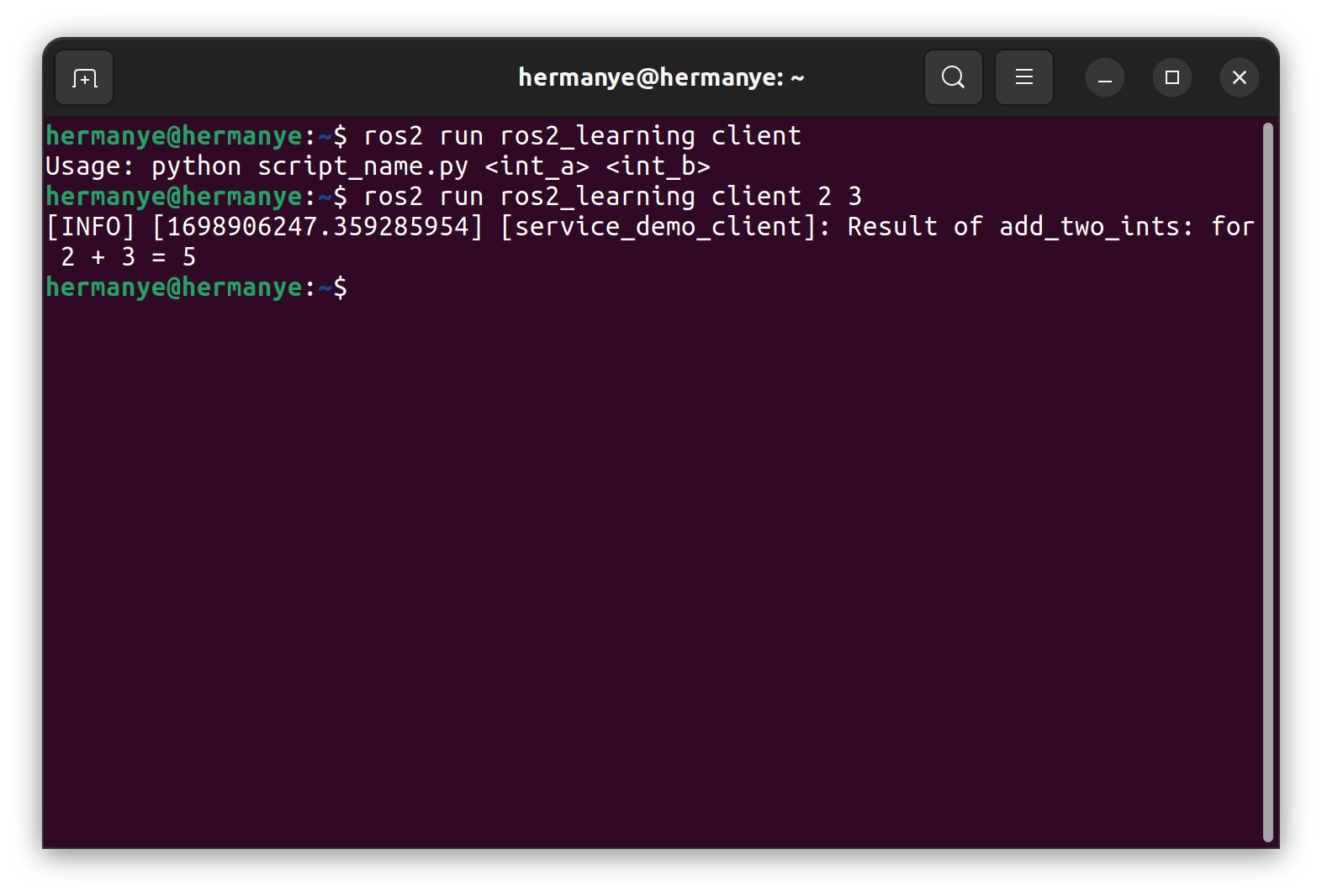













———TCP 连接建立)


)


